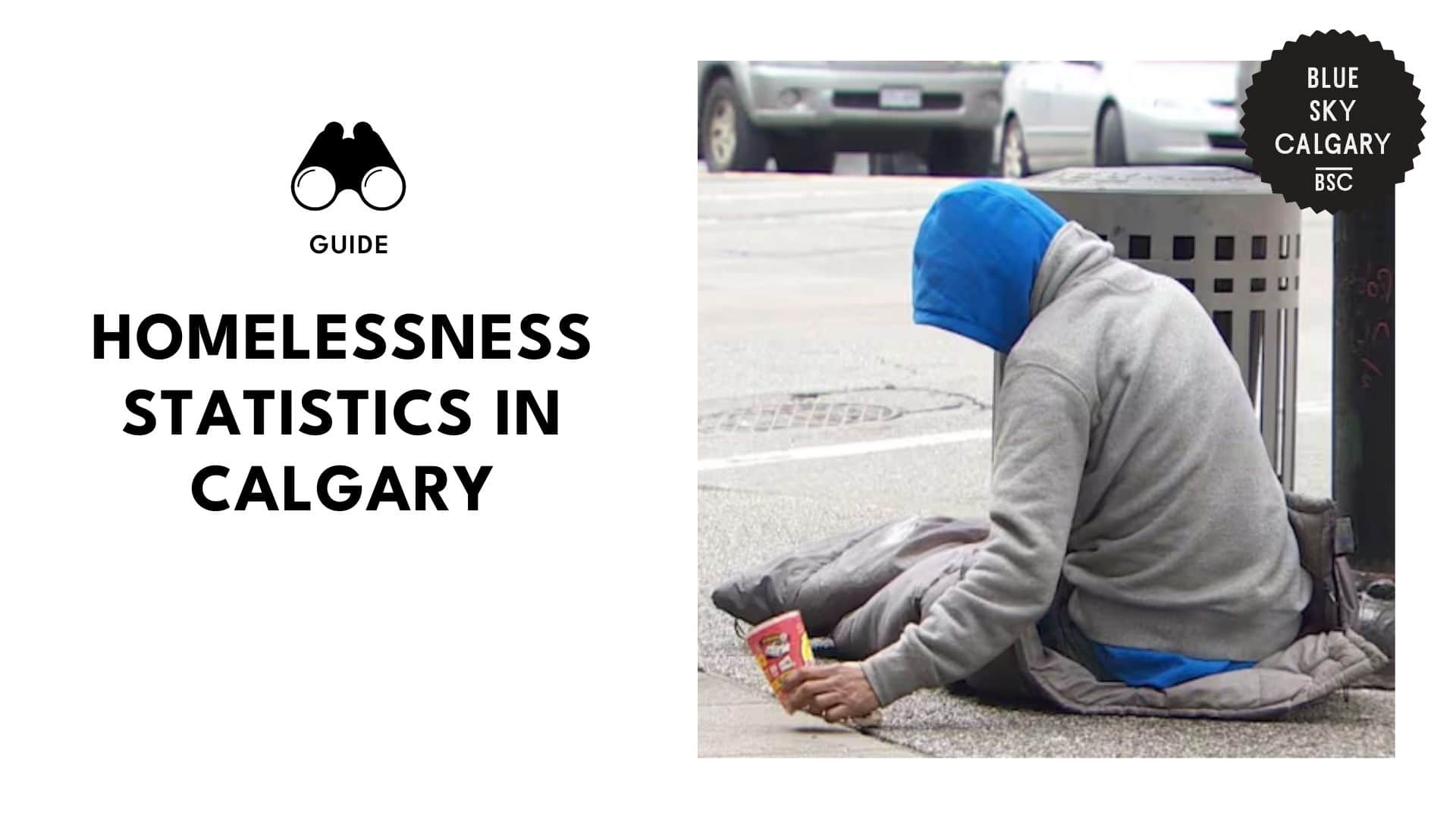Homelessness in Calgary: Statistics, Demographics, and Solutions
Key Insights
| Data from the Calgary Point-in-Time Count Report indicates that homelessness in Calgary rose sharply between 1992 and 2008, rising from 447 individuals to 3,601 over this period. The Homeless Hub shows that Calgary had the highest recorded number of homeless individuals in Alberta in 2022, with 2,782 people experiencing homelessness. According to the Calgary Homeless Foundation men made up the majority of Calgary’s homeless population in 2022, with 1,841 individuals, accounting for 66.1% of all recorded cases. The same report reveals that the age group of 25 to 44 had the highest number of homeless individuals, making up 43.5% of the population. The Calgary Point-in-Time Count Report shows that emergency shelters housed the largest share of Calgary’s homeless population in 2022, with 1,108 individuals staying in shelters. |
Data from the Calgary Point-in-Time Count Report shows that from 1992 to 2008, Calgary saw a dramatic rise in homelessness, as this number grew from 447 people to 3,601. This is an increase of 705.6% over 16 years.
The early 1990s had fairly low counts of homelessness, with 461 in 1993 and 615 in 1994, before almost doubling to 988 in 1996. This is a 60.7% increase over two years.
By the 2000s, this total had risen to 1,296, which is another 31.1% increase since 1996. In 2002, the total then rose to 1,737 – an increase of 34%.
This trend rose further in 2004, with 2,397 homeless individuals counted. This is an increase of 38% from 2002.
Homelessness in Calgary reached its peak in 2008 with 3,601 persons counted, which is an increase of 50.2% from 2004.
After 2008, the rate of homelessness started to fall. By 2012, this number had fallen to 3,383, which is a 6.1% drop from 2008.
Between 2014 and 2016, homelessness fell by 9.1% to 3,222 individuals. This downward trend continued into 2018 with the total dropping to 2,911 individuals, which is another 9.7% decrease.
The latest census in 2022 tallied 2,782 individuals identifying as homeless, which is a decline of 4.4% since 2018.
| Year | Homeless Count |
| 1992 | 447 |
| 1993 | 461 |
| 1994 | 615 |
| 1996 | 988 |
| 2000 | 1,296 |
| 2002 | 1,737 |
| 2004 | 2,397 |
| 2006 | 3,157 |
| 2008 | 3,601 |
| 2012 | 3,383 |
| 2014 | 3,544 |
| 2016 | 3,222 |
| 2018 | 2,911 |
| 2022 | 2,782 |

Regional Analysis
The Homeless Hub gives insights into homelessness trends across cities in Alberta.
Calgary recorded the most individuals living in homelessness in Alberta in 2022, with 2,782 people. Edmonton came second, with 2,519 people, 263 fewer than Calgary.
These two cities contained most of Alberta’s homeless, which may be an indication of the effect of the high cost of living and economic strain.
Outside of Edmonton and Calgary, the homeless population was much smaller.
Lethbridge was at 454, or 2,328 fewer than Calgary. Red Deer and Grande Prairie also had similar figures, at 334 and 328 respectively, both over 2,400 individuals fewer than Calgary.
Wood Buffalo had 162 homeless persons, which is 2,620 fewer than Calgary. Medicine Hat had the lowest number at just 70 individuals, 2,712 fewer than Calgary.
The much lower figures in these cities indicate that population size, regional economic conditions, and availability of housing programs are factors in deciding homelessness levels.
| City | Total number of people experiencing homelessness (2022) |
| Calgary | 2,782 |
| Edmonton | 2,519 |
| Grande Prairie | 328 |
| Lethbridge | 454 |
| Medicine Hat | 70 |
| Red Deer | 334 |
| Wood Buffalo | 162 |
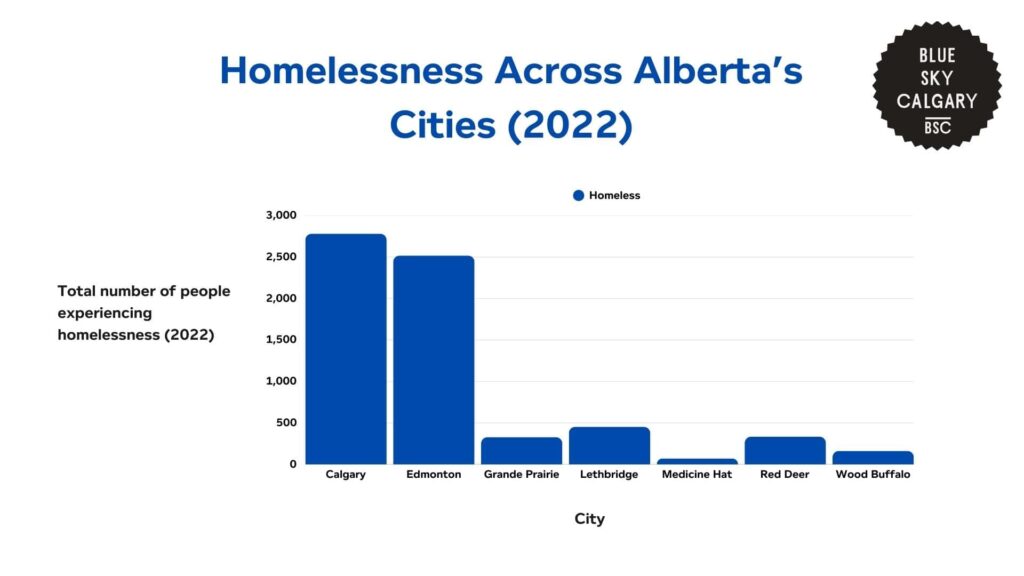
The Locations of Homeless Individuals in Calgary
The Calgary Homeless Foundation shows that in 2022, most of Calgary’s homeless were in emergency shelters with 1,108 individuals.
This is the greatest percentage of people who are homeless, which shows a growing dependence on temporary shelter facilities to address immediate housing needs.
Meanwhile, the citywide outreach program hosted 658 individuals, which reflects that a considerable number of individuals receive services from the city government but are still without permanent housing.
Among the vulnerable population, 305 were found in shelters for women experiencing violence, which highlights a concerning connection between homelessness and the issue of domestic violence against women.
Another 209 were counted in the Alberta Correctional Services Division, which indicates that some of the homeless individuals were in the justice system during the time of the study.
Substance treatment and medical facilities also provided shelter to a portion of Calgary’s homeless population. 206 people were receiving treatment or participating in detox programs.
Additionally, 30 people were counted in Alberta Health Services. These people may be residing in hospitals temporarily with no fixed residence.
Some homeless individuals were not sheltered, as 137 were counted in camps and 129 in transitional settings.
| Location | Counted |
| Emergency Shelter | 1,108 |
| Outreach – City Wide | 658 |
| Violence Against Women Shelter | 305 |
| Alberta Correctional Services Division | 209 |
| Treatment/Detox | 206 |
| Encampment | 137 |
| Transitional Housing | 129 |
| Alberta Health Services | 30 |
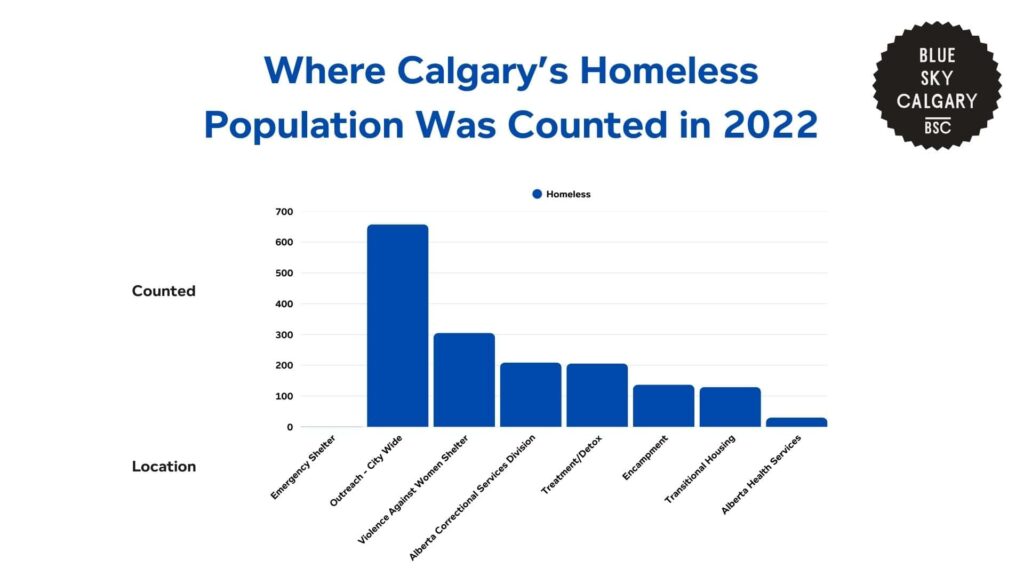
Demographic Breakdown of Homelessness Trends in Calgary
The Calgary Point-in-Time Count Report 2022 shows that homelessness affects demographic groups disproportionately.
Homelessness by Age
The age group 25 to 44 comprised the highest proportion of Calgary’s homeless population in 2022, at 1,210. This is 43.5% of all reported individuals.
Meanwhile, the second-largest category was those aged 45 to 64, at 648 individuals. This is 23.3% of the population, which shows that many working-age individuals could be facing economic instability.
Similarly, the young adult age group 18-24 comprised 181 persons, or 6.5% of the population. These may be persons who have limited job opportunities or experience unstable family conditions.
There were also 106 individuals between the ages of 6 and 12 years, and 58 between 13 and 17 years old. This amounts to a total of 5.9% of all documented persons.
100 children who were less than 5 years of age were also counted. This is 3.6% of the entire count, which shows how homelessness also affects families with children.
Finally, seniors aged 65 years and above formed the smallest reported group at 86 persons and made up 3.1% of the overall number.
| Age Group | Counted | Percentage of Total |
| Five and Under | 100 | 3.60% |
| 6-12 | 106 | 3.80% |
| 13-17 | 58 | 2.10% |
| 18-24 | 181 | 6.50% |
| 25-44 | 1,210 | 43.50% |
| 45-64 | 648 | 23.30% |
| 65+ | 86 | 3.10% |
| Unknown | 393 | 14.10% |
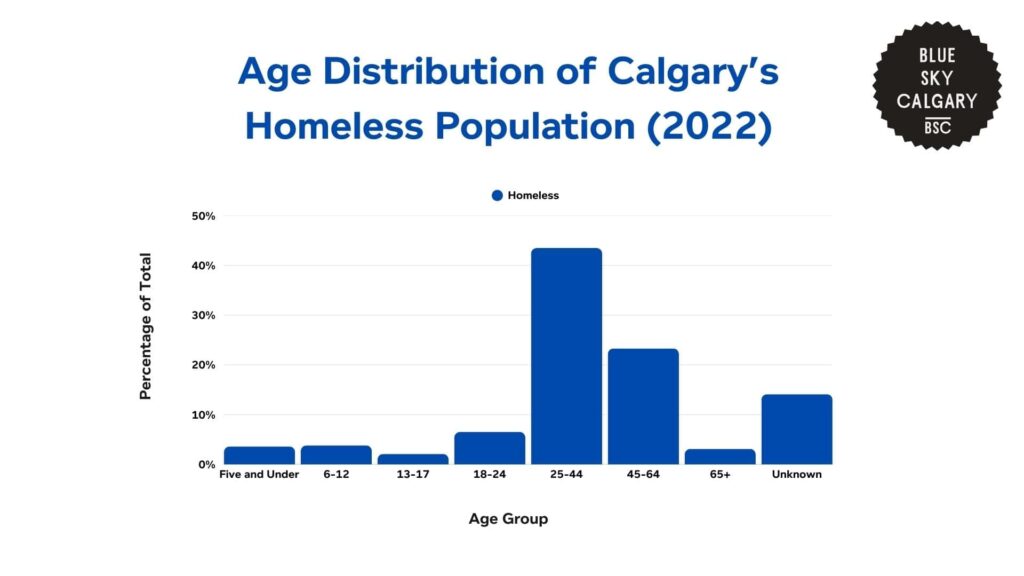
Homelessness by Gender Identity
Most of Calgary’s homeless people in 2022 were male, with 1,841 individuals. This represents 66.1% of the total people reported, showing that men suffer from homelessness at a much higher level.
Meanwhile, women were at 883 individuals, which is 31.7% of the total homeless population.
Though this overall rate is smaller, women experiencing homelessness also confront specific issues like domestic violence, gender-specific shelter exclusion, and childcare problems while being homeless.
Moreover, there were also 6 transgender people counted, making up 0.2% of the population, and 3 gender-diverse people, which is another 0.1%.
While the numbers are small, they do indicate the existence of the LGBTQ+ community among Calgary’s homeless population.
Transgender and gender-diverse individuals tend to have increased risks of discrimination, challenges in accessing shelter services, and obstacles to obtaining stable housing.
| Gender Identity | Counted | Percentage of Total |
| Male | 1,841 | 66.10% |
| Female | 883 | 31.70% |
| Transgender | 6 | 0.20% |
| Gender Diverse | 3 | 0.10% |
| Unknown | 39 | 1.40% |
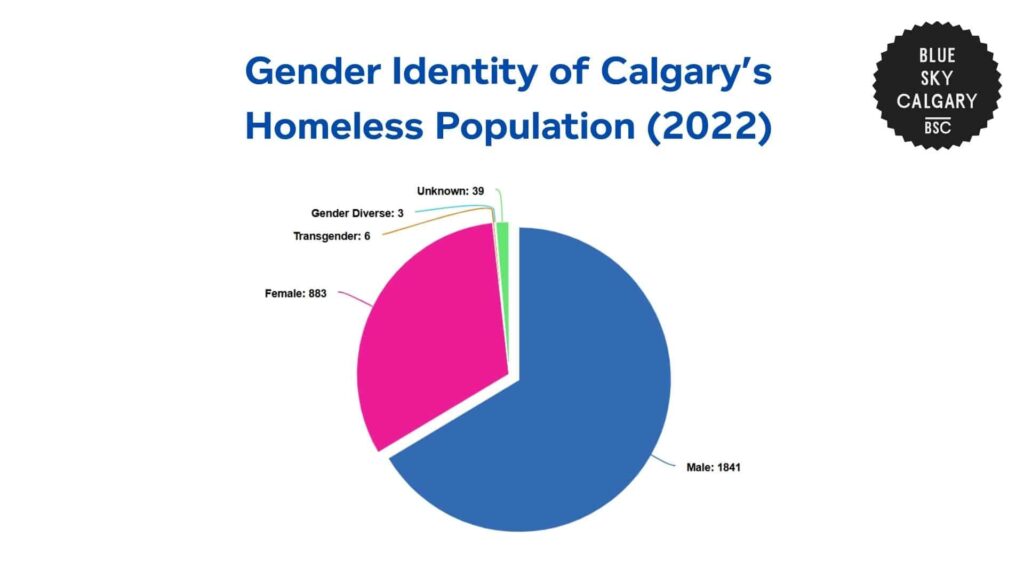
Homelessness by Ethnicity
The largest racial group among Calgary’s homeless was Caucasian, with 1,231 individuals, which is 44.2% of the total.
This implies that homelessness impacts a wide variety of racial backgrounds, including those belonging to the predominant demographic group in the city.
Meanwhile, there were 700 Indigenous people counted. This represents 25.1% of homeless individuals.
Indigenous people experience homelessness disproportionately due to historical displacement, systemic barriers, and limited availability of housing and employment opportunities.
Other races combined contributed 337 persons or 12.1% of the homeless population. This includes persons from racialized communities who could be further challenged by discrimination, reduced pay, or the absence of culturally suitable support services.
Notably, 514 persons were classified as having an unknown race, which is another 18.5% of the total population.
| Ethnicity | Counted | Percentage of Total |
| Caucasian | 1,231 | 44.20% |
| Indigenous | 700 | 25.10% |
| Other Racial Identity | 337 | 12.10% |
| Unknown | 514 | 18.50% |
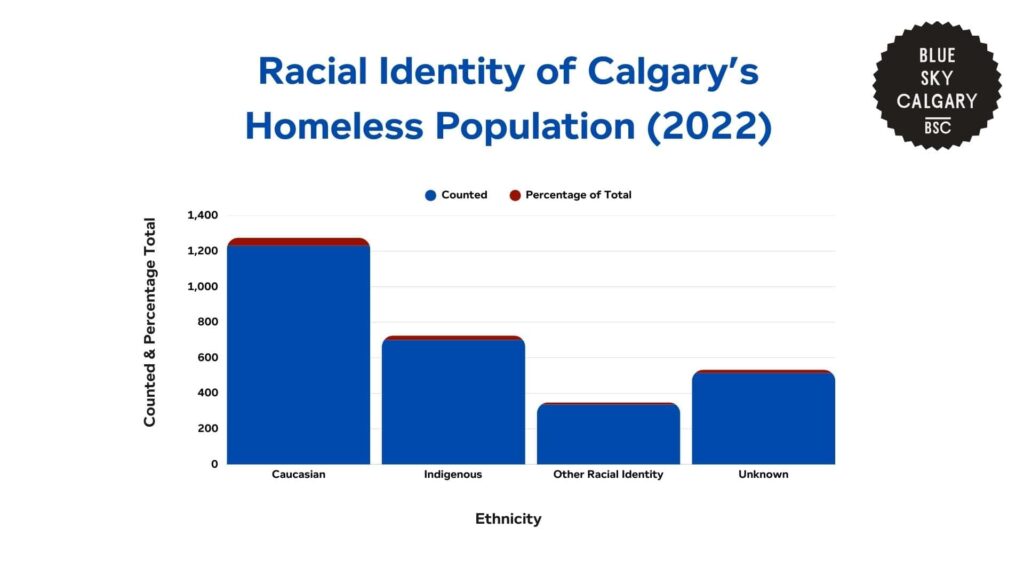
Costs and Consequences of Homelessness in Calgary
Statistics from the Homeless Hub Canada show that homelessness in Calgary can be quite costly to the city’s public systems, with costs per individual ranging from $30,000 to $54,000 per year.
These costs are largely due to emergency shelters, healthcare services, and interactions with the justice system. The use of these expensive interventions highlights the importance of sustainable housing solutions to lower public expenditure.
Emergency shelters represent one of the biggest costs, with yearly expenses as high as $20,000 per person. This covers staffing costs, operating expenses, and temporary housing.
However, these shelters are not permanent solutions to housing and this creates ongoing expenses as people experience a cycle of homelessness.
Medical expenses also contribute to Halifax’s financial burden since most homeless people need regular visits to the medical facilities for the management of long-term illnesses, conditions related to exposure, and mental health issues.
Emergency visits and inpatient treatments cost between $10,000 and $12,000 annually per individual, putting more pressure on the healthcare sector.
The criminal justice system also has added expenses due to the greater number of homeless individuals who engage with law enforcement through court hearings or time spent in detention.
These interactions contribute another $7,000 to $9,000 per person each year, adding even more to the city’s financial burden.
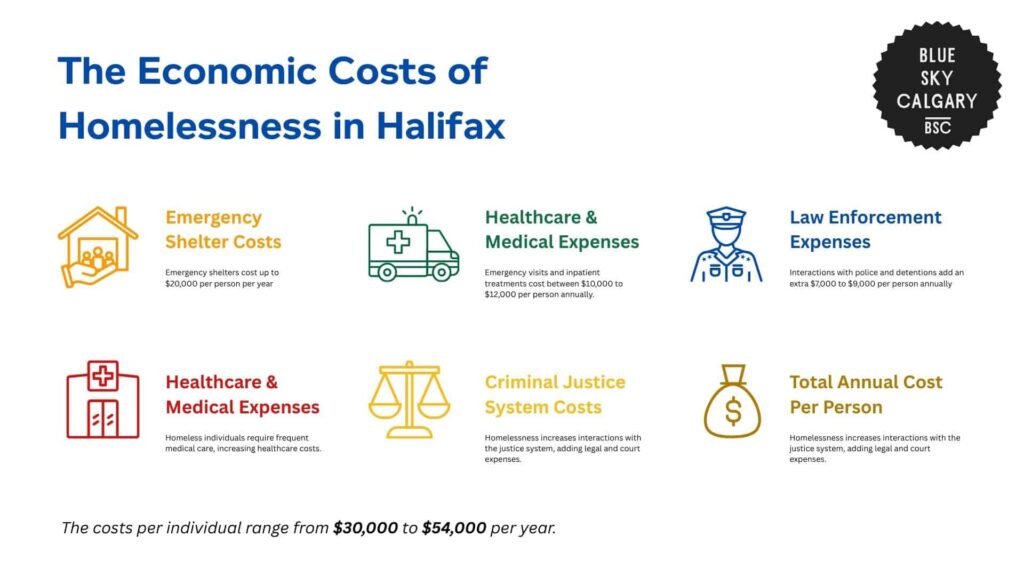
Interventions and Solutions to Homelessness in Calgary
The City of Calgary has pledged $9 million in investment to enhance its homelessness response by using targeted programs to address immediate and long-term needs.
Emergency shelter expansion, crisis intervention, mental health treatment, and outreach programs are supported through this funding, so those at risk of or experiencing homelessness are provided with stable housing.
One of the key elements of Calgary’s plan is the Extreme Weather Response, which is coordinated by the Calgary Homeless Foundation in collaboration with the City.
This initiative adds to the number of warming spaces provided during winter through increased capacity in existing shelters and social services agencies.
Considering that Calgary has around 2,000 emergency shelter beds, this strategy ensures that individuals without stable housing are not exposed during extreme weather.
In addition to offering short-term relief, the city also proactively collaborates with shelter providers to move people toward more stable housing arrangements.
Some organizations are also funded directly to provide specialized services.
For example, the Miskanawah Community Services Association operates the Nanatawiho Kamik – Healing Lodge, which offers culturally responsive mental health care and long-term support for Indigenous persons at risk of homelessness.
Furthermore, the Alpha House hosts the Downtown Ambassador Program and the HELP (Human-centered Engagement Liaison and Partnership) team.
These initiatives both work to help persons at risk of substance use, providing outreach and harm reduction services at the street level.
Calgary’s response also entails healthcare and crisis intervention initiatives.
The Alex Community Health Centre targets mental and physical health services for at-risk groups, providing necessary medical attention to those who are homeless or experiencing homelessness.
Meanwhile, the Distress Centre offers immediate crisis intervention service, linking people in crisis with several avenues of support to reduce further instability.
One of these avenues includes the CUPS Calgary Society’s Connect 2 Care program, which facilitates early intervention. They help individuals access medical and social services before their situations worsen.
Additionally, the Calgary Immigrant Women’s Association receives funding to provide crisis support for immigrant and refugee women, addressing the unique challenges they face in securing stable housing.
These strategies seek to break the cycle of homelessness by giving people the tools, assistance, and stability they need to progress toward permanent shelter and self-sufficiency.

The Future of Homelessness in Calgary
Homelessness in Calgary has fluctuated over the last thirty years, with totals reaching a high of 3,601 people in 2008 and then declining steadily to 2,782 in 2022.
Although recent strategies, such as expanded shelter space and interventions centered on housing have been important in this reduction, the city still faces many persistent difficulties.
As Calgary remains heavily dependent on emergency measures and economic strain increases, homelessness is likely to stay high over the next few years.
One of the determining factors of future trends will be the capacity of Calgary to scale up affordable housing initiatives in its homelessness response.
Without investment in permanent housing options, emergency shelters will continue to run near or at full capacity, especially during extreme weather events.
Even though homelessness has declined in the long term, these numbers remain high. Therefore, it will be vital for the city to amp up housing-first investments and expand prevention programs funding.
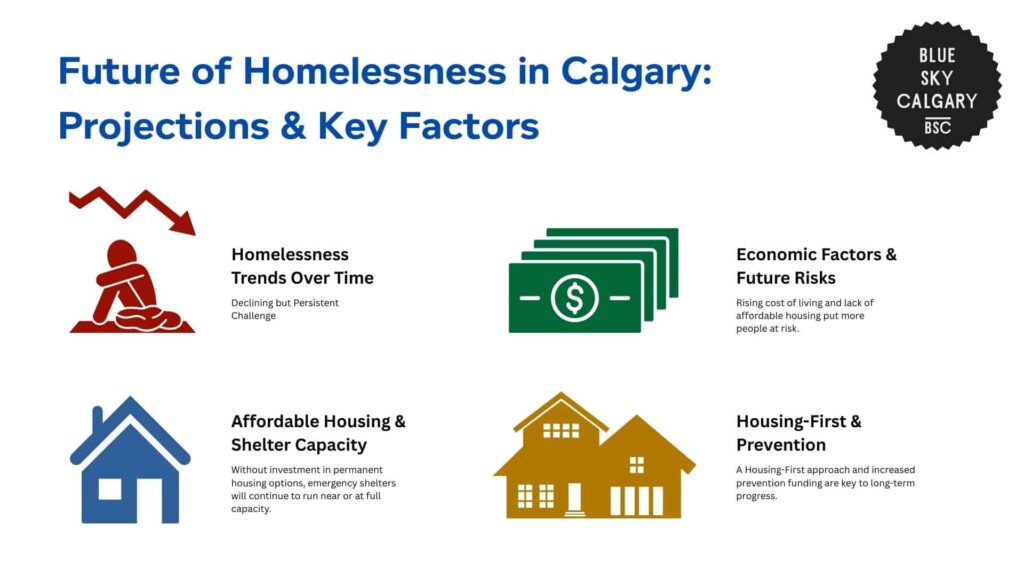
References
- Calgary Homeless Foundation. (n.d.). Point-in-time count data. Retrieved from https://www.calgaryhomeless.com/discover-learn/research-data/data/point-in-time-count/
- Calgary Homeless Foundation. (2024). 2022 point-in-time count report. Retrieved from https://www.calgaryhomeless.com/wp-content/uploads/2024/04/CHF-PiT-Count-Report2022.pdf
- Canadian Observatory on Homelessness. (n.d.). The Homeless Hub. Retrieved from https://homelesshub.ca/
- Canadian Observatory on Homelessness. (n.d.). Calgary community profile. Retrieved from https://homelesshub.ca/community_profile/calgary/
- Canadian Observatory on Homelessness. (n.d.). Edmonton community profile. Retrieved from https://homelesshub.ca/community_profile/edmonton/
- Canadian Observatory on Homelessness. (n.d.). Grande Prairie community profile. Retrieved from https://homelesshub.ca/community_profile/grande-prairie/
- Canadian Observatory on Homelessness. (n.d.). Lethbridge community profile. Retrieved from https://homelesshub.ca/community_profile/lethbridge/
- Canadian Observatory on Homelessness. (n.d.). Medicine Hat community profile. Retrieved from https://homelesshub.ca/community_profile/medicine-hat/
- Canadian Observatory on Homelessness. (n.d.). Red Deer community profile. Retrieved from https://homelesshub.ca/community_profile/red-deer/
- Canadian Observatory on Homelessness. (n.d.). Wood Buffalo community profile. Retrieved from https://homelesshub.ca/community_profile/wood-buffalo/
- Calgary Homeless Foundation. (n.d.). Plans and strategies. Retrieved from https://www.calgaryhomeless.com/discover-learn/our-approach/plans/
- City of Calgary. (n.d.). Homelessness in Calgary. Retrieved from https://www.calgary.ca/social-services/homelessness-in-calgary.html
- Calgary Homeless Foundation. (n.d.). Coordinated community extreme weather response (CCEWR). Retrieved from https://www.calgaryhomeless.com/ccewr/?utm_source=link&utm_medium=QR_code&utm_campaign=CCEWR&utm_content=CoC_ads
- Miskanawah Community Services Association. (n.d.). Miskanawah Community Services Association. Retrieved from https://miskanawah.ca/
- Alpha House Calgary. (n.d.). Alpha House Calgary. Retrieved from https://alphahousecalgary.com/?gclid=CjwKCAiAibeuBhAAEiwAiXBoJL4w8xFqHu1i2ZVGWoQ289MyrDCRa-Zr52mAWrNlwI7ioEYFalv1aRoCxlcQAvD_BwE
- The Alex. (n.d.). Community health centre. Retrieved from https://www.thealex.ca/program/community-health-centre/
- Distress Centre Calgary. (n.d.). Distress Centre Calgary. Retrieved from https://distresscentre.com/
- Calgary Immigrant Women’s Association. (n.d.). Resources for victims of family violence. Retrieved from https://ciwa-online.com/newcomer-services/gender-based-violence-mental-health/resources-for-victims-of-family-violence/

